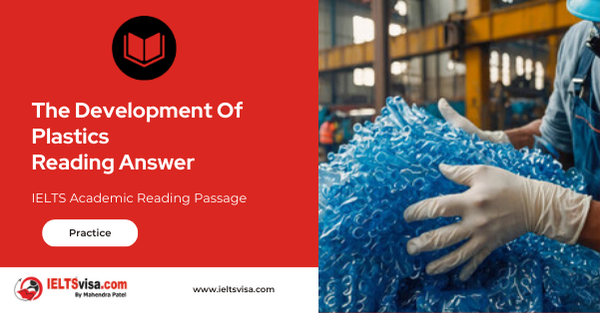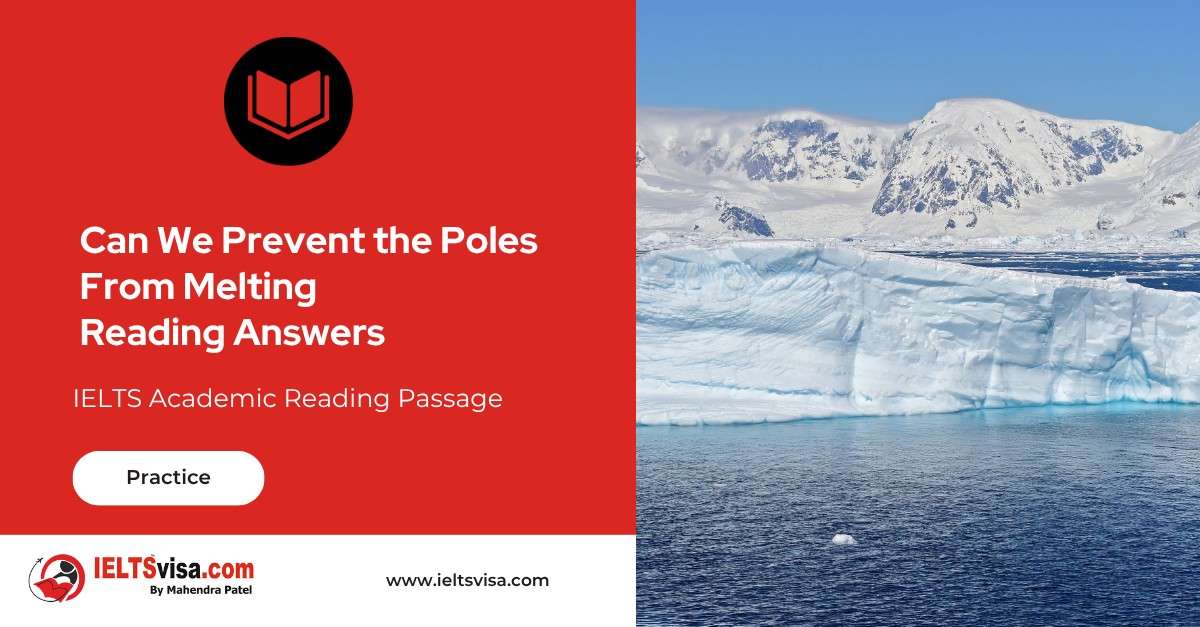The Development Of Plastics Reading Answer
IELTS Academic Reading Passage
When rubber was first commercially produced in Europe during the nineteenth century, it rapidly became a very important commodity, particularly in the fields of transportation and electricity. However, during the twentieth century a number of new synthetic materials, called plastics, superseded natural rubber in all but a few applications.
Rubber is a polymer—a compound containing large molecules that are formed by the bonding of many smaller, simpler units, repeated over and over again. The same bonding principle—polymerization—underlies the creation of a huge range of plastics by the chemical industry.
The first plastic was developed as a result of a competition in the USA. In the 1860s, $10,000 was offered to anybody who could replace ivory—supplies of which were declining—with something equally good as a material for making billiard balls. The prize was won by John Wesley Hyatt with a material called celluloid. Celluloid was made by dissolving cellulose, a carbohydrate derived from plants, in a solution of camphor dissolved in ethanol. This new material rapidly found uses in the manufacture of products such as knife handles, detachable collars and cuffs, spectacle frames and photographic film. Without celluloid, the film industry could never have got off the ground at the end of the 19th century.
Celluloid can be repeatedly softened and reshaped by heat, and is known as a thermoplastic. In 1907, Leo Baekeland, a Belgian chemist working in the USA, invented a different kind of plastic, by causing phenol and formaldehyde to react together. Baekeland called the material Bakelite, and it was the first of the thermosets—plastics that can be cast and moulded while hot, but cannot be softened by heat and reshaped once they have set. Bakelite was a good insulator, and was resistant to water, acids and moderate heat. With these properties it was soon being used in the manufacture of switches, household items such as knife handles, and electrical components for cars.
Soon chemists began looking for other small molecules that could be strung together to make polymers. In the 1930s British chemists discovered that the gas ethylene would polymerize under heat and pressure to form a thermoplastic they called polythene. Polypropylene followed in the 1950s. Both were used to make bottles, pipes and plastic bags. A small change in the starting material—replacing a hydrogen atom in ethylene with a chlorine atom—produced PVC (polyvinyl chloride), a hard, fireproof plastic suitable for drains and gutters. And by adding certain chemicals, a soft form of PVC could be produced, suitable as a substitute for rubber in items such as waterproof clothing. A closely related plastic was Teflon, or PTFE (polytetrafluoroethylene). This had a very low coefficient of friction, making it ideal for bearings, rollers, and non-stick frying pans. Polystyrene, developed during the 1930s in Germany, was a clear, glass-like material, used in food containers, domestic appliances and toys. Expanded polystyrene—a white, rigid foam—was widely used in packaging and insulation. Polyurethanes, also developed in Germany, found uses as adhesives, coatings, and—in the form of rigid foams—as insulation materials. They are all produced from chemicals derived from crude oil, which contains exactly the same elements—carbon and hydrogen—as many plastics.
The first of the man-made fibres, nylon, was also created in the 1930s. Its inventor was a chemist called Wallace Carothers, who worked for the Du Pont company in the USA. He found that under the right conditions, two chemicals— hexamethylenediamine and adipic acid—would form a polymer that could be pumped out through holes and then stretched to form long glossy threads that could be woven like silk. Its first use was to make parachutes for the US armed forces in World War H. In the post-war years nylon completely replaced silk in the manufacture of stockings. Subsequently many other synthetic fibres joined nylon, including Orion, Acrilan and Terylene. Today most garments are made of a blend of natural fibres, such as cotton and wool, and man-made fibres that make fabrics easier to look after.
The great strength of plastic is its indestructibility. However, this quality is also something of a drawback: beaches all over the world, even on the remotest islands, are littered with plastic bottles that nothing can destroy. Nor is it very easy to recycle plastics, as different types of plastic are often used in the same items and call for different treatments. Plastics can be made biodegradable by incorporating into their structure a material such as starch, which is attacked by bacteria and causes the plastic to fall apart. Other materials can be incorporated that gradually decay in sunlight—although bottles made of such materials have to be stored in the dark, to ensure that they do not disintegrate before they have been used.
Complete the table below Choose NO MORE THAN THREE WORDS from the passages for each answer Write your answer in boxes 1-7 on your answer sheet.Questions 1-7
| Name of Plastic | Date of Invention | Original Region | Property | Common Use |
|---|---|---|---|---|
| Celluloid | 1860s | US | 1. | |
| 2. | 1907 | US | Can be cast and molded but not softened by heat | Household items and car parts |
| Polythene | 1930 | 4. | Bottles | |
| Rigid PVC | 5. | |||
| Polystyrene | 1930s | Germany | 6. | Food container |
| Polyurethane | 1930s | Germany | 7. foams | Adhesives, coatings, insulation |
Do the following statements agree with the information in Reading Passage? In boxes 8-13 on your answer sheet write TRUE if the statement agrees with the information FALSE if the statement contradicts the information NOT GIVEN if there is no information about the statement 8 The chemical structure of plastic is very different from that of rubber. 9 John Wesley was a famous chemist. 10 Celluloid and Bakelite react to heat in the same way. 11 The mix of different varieties of plastic can make the recycling more difficult. 12 Adding starch into plastic can make plastic more durable. 13 Some plastic containers have to be preserved in special conditions.Questions 8-13

Solution For: The Development Of Plastics Reading Answer
| 1. photographic film | 8. FALSE |
| 2. Bakelite | 9. NOT GIVEN |
| 3. switches | 10. FALSE |
| 4. Britain/UK | 11. TRUE |
| 5. fireproof | 12. FALSE |
| 6. clear and glass-like | 13. TRUE |
| 7. rigid |
Review and Practice
- Regularly practice with IELTS reading samples and time yourself to get used to the pressure of the exam.
- Review your mistakes to understand where you went wrong and how to avoid similar errors in the future.
Our Books
Master IELTS Speaking Part 1
IELTS Writing Task 1 Book
IELTS Writing Task 2 Book
The Development Of Plastics Reading Answer Explanation
Comin Soon
Practice IELTS Other Modules
IELTS Listening
The IELTS Listening test assesses how well you can understand spoken English in various contexts. It lasts about 30 minutes and is divided into four sections with a total of 40 questions. The listening tasks become increasingly difficult as the test progresses.
IELTS Academic Reading
The IELTS Academic Reading section assesses your ability to understand and interpret a variety of texts in academic settings. It is designed to evaluate a range of reading skills, including skimming for gist, reading for main ideas, reading for detail, understanding inferences, and recognizing a writer's opinions and arguments.
IELTS Speaking
The IELTS Speaking test assesses your ability to communicate in English on everyday topics. It lasts 11-14 minutes and consists of three parts: introduction, cue card, and a discussion based on the cue card topic.
IELTS General Reading
IELTS General Reading tests your ability to understand and interpret various types of texts. Here are some key areas and types of content you can expect to encounter in the reading section, along with tips for effective preparation.
IELTS Academic Writing Task 1
In IELTS Academic Writing Task 1, you are presented with a visual representation of information, such as graphs, charts, tables, or diagrams, and you are required to summarize, compare, or explain the data in your own words.
IELTS General Writing Task 1
In IELTS General Writing Task 1, you are required to write a letter based on a given situation. The letter can be formal, semi-formal, or informal, depending on the prompt. Here’s a breakdown of the key components to include in your letter
IELTS Academic Writing Task 2
In IELTS Academic Writing Task 2, you are required to write an essay in response to a question or topic. Here’s a guide to help you understand the essential elements of this task
IELTS Exam Tips
To succeed in the IELTS exam, practice regularly, familiarize yourself with the test format, improve your vocabulary, develop time management skills, and take mock tests to build confidence.
Grammer for IELTS
Grammar is the foundation of effective communication in English. Understanding tense usage, subject-verb agreement, and sentence structure enhances clarity and coherence in writing and speaking.
Vocabulary for IELTS
Vocabulary plays a crucial role in the IELTS (International English Language Testing System) exam, especially in the Speaking and Writing sections. Here’s an overview of why vocabulary is important and how it impacts your performance
RECENT IELTS SAMPLES QUESTIONS AND ANSWERS
Walking with dinosaurs
Peter L. Falkingham and his colleagues at Manchester University are developing techniques that...
Money as the Unit of Amount Reading Answers
The most difficult aspect of money to understand is its function as a unit of account. In...
WEATHERING IN THE DESERT
In the deserts, as elsewhere, rocks at the earth's surface are changed by weathering, which...
Nature on Display in American Zoos
The first zoo in the United States opened in Philadelphia in 1874, followed by the Cincinnati...
Can We Prevent the Poles From Melting
Such is our dependence on fossil fuels, and such is the volume of carbon dioxide we have...
Air conditioning the earth reading answers
The circulation of air in the atmosphere is activated by convection, the transference of heat...













